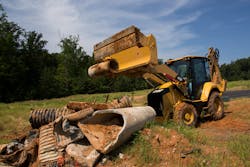Backhoe loaders, once the victims of cannibalization from compact excavators and skid steers or compact track loaders—and perhaps thought to be relegated to being a niche machine for municipalities and public utilities—are making a comeback with contractors.
Reports of their marginalization are premature, according to Dennis Tovar, a 40-year sales veteran of McCann Industries, a Case Construction Equipment dealer based in Bolingbrook, Illinois. It's safe to say that he's seen a cycle, or 10, during his career.
See more: the top backhoe loaders of 2022.
“Going back the last five to 10 years, probably longer than that, loader backhoe sales really diminished because of the advent of mini and midi excavators—midi being the 18,000- to 20,000-pound category,” Tovar says. “Contractors initially would say ‘I can send a skid steer or a tracked machine out with a mini or midi on one trailer and get the work done.’
“As time has gone on, what’s happened is there was a resurgence, a realization of what a loader backhoe could do,” Tovar says. “You can drive it across town. You don’t always have to put it on a trailer. You can dig a trench, lay the pipe, backfill it with the loader bucket, and you can load out a dump truck with it, so it’s like a Swiss Army Knife. That’s how the resurgence, or rediscovery, of the loader backhoe has come.”
When sales were down, Tovar says the backhoe banner was kept flying not only by municipalities, but also by major underground, mechanical, and utility contractors. “It was people who were doing major pipeline and gas contracts, and major electrical installs along the roads, because they can run up and down the roads with pipes strewn across the loader frame,” Tovar says.
According to Tovar, Case is the only backhoe loader manufacturer that allows a user to strap down five to 8 pipes across the loader frame and travel down the road.
Benefits of backhoe loaders
For the category, there are still the classic labor and cost efficiencies. One operator and one machine, for example. And if that operator has a CDL, they can also bring the backhoe in on a trailer.
“People are rediscovering the loader backhoe for its efficiencies and utilization of what it can truly do," Tovar says. "A lot of that has to do with all you need to do is get them to a job site area, and start four or five crews going in any different direction with them, and you’re not talking about having two machines. Just one."
He doesn't think the recent resurgence is going to go away; rather it will have a peak and level out a bit.
"At one point in time in this industry, people were really kind of exalting the doom and gloom of the loader backhoe, that it's going to go away and never come back," Tovar says. "And what the utilization is actually proving out is that it's not going to go away. It's not going to be the doom and gloom, and I think it's really out of economics."
He also says that this older machine form will benefit from new technology. [See the nearby sidebar.]
"Trust me, the loader backhoe will enjoy the development of today’s technologies; Case has introduced an all-electric one," Tovar says. "Given California recently saying they don’t want anybody to have gasoline or diesel vehicles, if all you did was sell loader backhoes to California at some point in time in the future, then case has that market—that would drive that market in an unbelievable way.
"Other municipalities across the nation would follow suit, so there’s a place [for the category] there," Tovar says. "I’m not saying it’s going to mandate or take over the whole market, but if one state drives that market, I think Case is going to get that business because I believe to date they’re the first one that has created that."
Contractors are not only asking for technology, they're looking for conveniences and operating efficiencies, Tovar says.
Operating advantages to backhoe loaders
"I don’t think a lot has changed in that way,” Tovar says. “But what’s popular with the Case machine are the exclusives. For example, there’s comfort steer, where you press a button when you’re on a job site and you turn [the wheel] three rotations to make a turn into one and a half. With Eco fuel efficiency, you hit a button and you’re using a lot less fuel. There's Pro Control swing on the backhoe, when the operator swings the backhoe and he stops the backhoe, it doesn’t sit there and bounce back and forth."
With simpler "cushioning" technology, there's the possibility of wearing out pins and bushings trying to control the backhoe bounce.
Other items Tovar mentions as popular with customers include an integrated hydraulically released bucket. "We have an integrated hydraulic coupler and when people look at it, they don’t see an add-on coupler. It’s not a Wain Roy, it’s not a Werk Brau, it’s two pins at the end of the dipper that come out and contract, and you don’t even realize when you look at it that there’s a coupler there."
A button in the cab allows the pins to come out or retract to take attachments on and off.
Another feature contractors ask for is the over-center backhoe. “When you lock it over center, you’re throwing about 15 percent of that weight on the front axle, achieving good balance, and you’re able to go up and down the road 25 mph," Tovar says.
Cost efficiencies, good utilization, and today's labor shortages also point to a more secure future for the category.
"I’ve been doing this for 40 years, and the loader backhoe of today lift more weight than ever on the front," Tovar says. "And they lift way more weight than ever imagined on the back, and there’s more digging force.”
In short, specs still matter, too.
What's new in backhoe loaders
Now that general contractors are seemingly back on the backhoe bandwagon, let's look at what OEMs have been doing to court them since the last time Construction Equipment looked at the category during the heart of the pandemic in 2020.
John Deere has made numerous updates to its L Series backhoes.
Ranging across the L Series backhoe loader lineup, the updates include engine upgrades, new pressure-compensated load-sensing (PCLS) hydraulics on the 310SL model, and machine control improvements. The 310L, 310SL, 315SL, 310SL HL, and 410L models are now equipped with a 4.5L John Deere PowerTech EWL engine, increasing power, improving torque, and providing greater reliability, Deere says.
This Tier 4-F engine results in a boost in horsepower across the models, while the removal of the exhaust gas recirculation system and components is meant to improve reliability. The redesign also includes improved filter locations for easier access when changing or servicing fuel and diesel exhaust fluid filters.
Additionally, the John Deere 310SL is now available with PCLS hydraulics. Already offered on the 310SL HL, 410L and 710L, the PCLS system results in increased productivity and improved backhoe controllability at any engine speed, according to Deere. Also, trenching operation can now be conducted at lower engine rpm, reducing fuel consumption and lowering job site noise. The 310SL has been equipped with Lift Mode. When enabled, it automatically sets the engine speed to 1,400 rpm and increases max hydraulic pressure to 4,000 psi, for up to a 10- to 15-percent increase in backhoe lift capacity.
In the cab, buttons for the horn, selective flow, auxiliary proportional roller, and extendable dipper stick have been integrated into the backhoe pilot controls for ease of use.
Caterpillar has changed its nomenclature, replacing F2 Series backhoe loaders with models using the nomenclature without suffixes. Models 415, 416, 420, 420 XE, and 430 use a new engine, the Cat C3.6, that is up to 10 percent more fuel efficient. Four wheel drive is now standard, with no 2WD versions available in North America, and the IT version has been eliminated, with all new models able to use an IT coupler. Dig depths range from 14 feet to 15 feet 2 inches, and horsepower ratings range from 70 to 107.
The Cat C3.6 engine uses selective catalytic reduction (SCR) with diesel exhaust fluid (DEF) and a diesel particulate filter (DPF) for the 416, 420, and 430 models. The 415 backhoe loader requires only the DPF to meet U.S. EPA Tier 4 requirements.
Selectable power management modes on the 420, 420 XE, and 430 models offer the choice of Standard Mode engine performance for increased fuel savings or Standard Plus Mode to boost machine performance by maximizing backhoe implement speeds. These models also feature adjustable auxiliary hydraulic flow on the loader, so the operator can fine-tune machine hydraulics to power attachments like brooms and hydraulic angling snow pushes.
JCB is still touting its 1CX tracked backhoe loader, which rides on rubber tracks. With a transport weight under 10,000 pounds, it can easily be towed to job sites. It also has a side-shift backhoe that can dig to 10 feet 1 inch.






